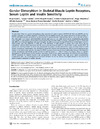Please use this identifier to cite or link to this item:
https://accedacris.ulpgc.es/jspui/handle/10553/6542
| Title: | Gender dimorphism in skeletal muscle leptin receptors, serum leptin and insulin sensitivity | Authors: | Guerra, Borja Fuentes, Teresa Delgado-Guerra, Safira Guadalupe-Grau, Amelia Olmedillas, Hugo Santana, Alfredo Ponce-González, Jesús Gustavo Dorado, Cecilia Calbet, Jose A. L. |
UNESCO Clasification: | 2411 Fisiología humana | Keywords: | Leptin Testosterone Fat |
Issue Date: | 2008 | Project: | Mecanismos Fisiológicos y Moleculares de la Reducción de Masa Grasa en Seres Humanos Mediante Ejercicios de Musculación. | Journal: | PLoS ONE | Abstract: | To determine if there is a gender dimorphism in the expression of leptin receptors (OB-R170, OB-R128 and OB-R98) and the protein suppressor of cytokine signaling 3 (SOCS3) in human skeletal muscle, the protein expression of OB-R, perilipin A, SOCS3 and alpha-tubulin was assessed by Western blot in muscle biopsies obtained from the m. vastus lateralis in thirty-four men (age = 27.1+/-6.8 yr) and thirty-three women (age = 26.7+/-6.7 yr). Basal serum insulin concentration and HOMA were similar in both genders. Serum leptin concentration was 3.4 times higher in women compared to men (P<0.05) and this difference remained significant after accounting for the differences in percentage of body fat or soluble leptin receptor. OB-R protein was 41% (OB-R170, P<0.05) and 163% (OB-R128, P<0.05) greater in women than men. There was no relationship between OB-R expression and the serum concentrations of leptin or 17beta-estradiol. In men, muscle OB-R128 protein was inversely related to serum free testosterone. In women, OB-R98 and OB-R128 were inversely related to total serum testosterone concentration, and OB-R128 to serum free testosterone concentration. SOCS3 protein expression was similar in men and women and was not related to OB-R. In women, there was an inverse relationship between the logarithm of free testosterone and SCOS3 protein content in skeletal muscle (r = -0.46, P<0.05). In summary, there is a gender dimorphism in skeletal muscle leptin receptors expression, which can be partly explained by the influence of testosterone. SOCS3 expression in skeletal muscle is not up-regulated in women, despite very high serum leptin concentrations compared to men. The circulating form of the leptin receptor can not be used as a surrogate measure of the amount of leptin receptors expressed in skeletal muscles. | URI: | https://accedacris.ulpgc.es/handle/10553/6542 | ISSN: | 1932-6203 | DOI: | 10.1371/journal.pone.0003466 | Source: | Plos One[ISSN 1932-6203],v. 3 (10) |
| Appears in Collections: | Artículos |
SCOPUSTM
Citations
55
checked on Jun 8, 2025
WEB OF SCIENCETM
Citations
53
checked on Jun 8, 2025
Page view(s)
173
checked on May 31, 2025
Download(s)
81
checked on May 31, 2025
Google ScholarTM
Check
Altmetric
Share
Export metadata
Items in accedaCRIS are protected by copyright, with all rights reserved, unless otherwise indicated.
